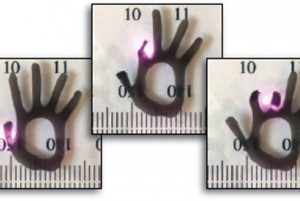A new material controlled by light may help scientists build better soft-bodied robots. The UC Berkeley scientists created the gel using graphene and a synthetic protein similar to elastin, which is found in humans’ blood vessels, skin and more. The synthetic elastin, created from genetically engineered bacteria, absorbs water at room temperature, but at higher temperatures it expels the water and shrinks.
Inspired by the way plants grow toward light sources, a phenomenon known as phototropism, bioengineers from the University of California, Berkeley have created a hydrogel that could be manipulated by light. This new material, shaped like a hand about two centimeters wide can be controlled by near-infrared laser light
Graphene produces heat when exposed to near-infrared light. Together, the two materials make a light-controlled gel, said professor Seung-Wuk Lee of UC Berkeley’s department of bioengineering. “The graphene is heated by the light, and then the elastin is responding to the heat induced by the light.”
By making parts of the new gel less porous, the team could control how the material bends. The more porous side absorbed and expelled water faster, making the material shrink unevenly, which resulted in a gel that could bend in a predictable, repeatable way.
For many people, the word “robot” is likely to conjure up images of metal and mechanical men. But instead of creating robots in our own image, the relatively new field of “soft robotics” takes inspiration from creatures such as octopuses, squids, starfish and caterpillars for soft, flexible robots that could squeeze through small spaces.
The material by itself which Lee and his team have only thus far assembled into tiny structures does not make a robot. So far, the “robots” built include a 0.4-inch (1 cm) “worm” that crawls when exposed to the infrared laser, and a roughly 0.8-inch (2 cm) hand that bends its fingers. But the proof of concept could someday be used to build complex robots, such as one that is shaped like and moves like an octopus, Lee said.
“Shape-changing gels such as ours could have applications for drug delivery and tissue engineering,” said study principal investigator Seung-Wuk Lee, associated professor of bioengineering.
Lee suggests that the new material could be used for drug delivery. Perhaps the material could soak up a liquid drug, injected into a patient’s bloodstream, and then squeezed out of the material’s pores at the right place.
Since infrared light penetrates skin, it is not impossible to imagine this in the future .He feels that someday we could use this shape-changing gel as a replacement for lost limbs or maybe even replace our tissues with a light-controlled gel.
For more information please visit: www.berkeley.edu


Comments are closed.